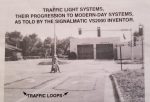
Early in the 1960s, my father Clifford Strang Jr. was working for a large city traffic department. His responsibilities were to install new traffic lights and to troubleshoot and repair malfunctioning lights.
In 1964, he designed and built an electronic test simulator to repair traffic controllers more efficiently in the shop. Not all signalized intersections were created equal. They had various types of controllers and different functions at the various intersections.
Here is an explanation of how vehicles are now sensed by the majority of modern day electronic light systems. If you have experience or knowledge of metal detectors, you know that if you are looking for coins or metal with a metal detector, it will give you an audio or electronic meter reading when you are near metal. Now think of this metal detector as being in the roadway. This, of course, is much larger than the hand-held detectors people locate coins with, the principle applies. When a car pulls up to the intersection, it is driven through a weak radio wave. When the radio wave is disturbed by the vehicle, the traffic system is signaled of its presence.
A motorcycle is more difficult for the system to detect since it has much less metal. Many times it will ignore the presence of a motorcycle. After the inductive traffic loops became more common, my father decided to try solving the problem.
The answer was the VS2000, a vehicle simulator! Predecessor to the Signalmatic unit today. The unit, when mounted on the bottom of the motorcycle or under the saddle bag or on any 1/2′ to 1 1/4′ round bar, draws a small amount of power from the motorcycle’s electrical system when you put on your brakes. When riding your motorcycle over the traffic loop, the unit creates a weak radio wave that interacts with the signal from the traffic loop. This interaction starts the sequence going so you will get the green light, the same as a car.
.





